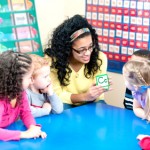Time to play cards!
But wait: which one?
And how to play with very young learners (preschool-aged and younger)?

Time to play cards!
Lets start with Concentration, also known as Memory.
Younger children may not understand the game and may not react well to competitive elements of the game.
So, here are some ideas for how to play Concentration with learners 5 and under.

Step 1.Teach how to match things in general.
Before your lesson starts, place one card from each pair at various places around the room.
Sit down with your young learners with the other cards.
Show them one of the cards (for example, a picture of an apple.)
Say, Look, an apple!
Give the apple card to one of the children and say, Can you find another apple?
Look around the room to show the child you are looking for another apple.
The child goes and gets the other apple card.
Give another card to another child and have them find the matching card.
Do this until all of the cards have been matched.
Step 2.Introduce the memory element of the game.
Take 3 pairs of matching cards.
Show each card to the students, name it, and place it face down.
Talk about each card as you show it.
For example, you’re able to say, Ooh look!
A nice red apple!
Do you like apples?
(Place the card face down.)
Lets look at the next card.
(Place the card face down.)
For example, turn over an apple card and then ask, I wonder where the other apple is.
Which one is the apple card?
The children will help you find the apple card by pointing to it.
Turn over the card.
If it is the apple card, say, Yes!
We found the apple!
If it not the apple card, say, Thats not an apple.
Lets give it another spin!
Continue until you have matched each of the cards.
Add a couple more pairs of cards and loop back and try, finding the cards together.
Step 3.Introduce turn taking.
Youve just added an extra element of challenge.
There are more cards now and the children dont have as much time to remember where they are.
Say, Let me see if I can find a match.
Turn over one card, and then turn over another card.
Its a good idea to intentionally turn over two cards that dont match.
You want to show the children that its no big deal.
Its okay if you dont find a match.
you might say happily, Ooops!
These cards are different.
Turn to the child next to you and say, Can you find a match?
If the child needs help, show her/him how to turn over one card.
Look at the first card and name it.
Hey, a peach!
Can you find another peach?
The child turns over another card.
If it is a match, say, Great job!
You found a match.
You have two peaches!
Put the two cards in front of that child.
If it is not a match, say Ooops!
Either way, turn to the next child and say, Can you find a match?
Continue around the circle.
This is really important for playing card games with young learners.
Its very common for children this age to become upset if they feel like they are losing a game.
Step 4.Collect the cards.
Have the children count their cards.
When they give them to you, have them name each of the cards.
Or, you could ask for cards by name and have the children bring them to you.
Dont make a big deal out of which children have the most cards.
There are no winners or losers, its just an activity.
Have fun with it!
As children get older, you could add extra elements to the game.
it’s possible for you to make it more competitive.
But with very young learners, you dont need these competitive elements to make games fun.
to keep the interest high.